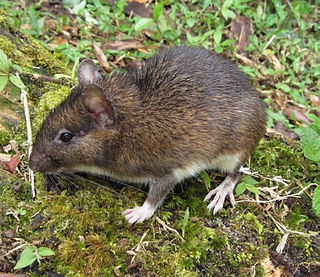The tufted-tailed spiny tree-rat or furtive spiny tree-rat is a spiny rat species known from Amazonas, northwestern Brazil, where it is found in tropical rainforest. The species is arboreal.

The Guyenne spiny-rat or Cayenne spiny rat, is a spiny rat species found in Brazil, Colombia, French Guiana, Guyana, Suriname and Venezuela.
The stiff-spine spiny-rat or Tefe spiny rat, is a spiny rat species found in Brazil and Colombia.

The mouse-tailed Atlantic spiny-rat is a spiny rat species from South America. It is found in Brazil.

The white-spined Atlantic spiny rat is a spiny rat species endemic to Brazil.

Elias's Atlantic spiny-rat or the Rio de Janeiro spiny rat, is a spiny rat species from South America. It is found in Brazil.

Trinomys gratiosus is a species in the mainly South American family Echimyidae, the spiny rats; it occurs in southeast Brazil from the south bank of the River Doce, Espirito Sante, southward to Teresopolis, Rio de Janeiro.
Ihering's Atlantic spiny-rat or Ihering's spiny rat is a spiny rat species from South America. It is endemic to Brazil, and was named in honor of Hermann von Ihering.

The dark-caped Atlantic spiny rat or Mirapitanga spiny rat, is a spiny rat species from South America. It is found in Brazil.

The spiked Atlantic spiny-rat or Espirito Santo spiny rat, is a spiny rat species from South America. It is found in Brazil.

The hairy Atlantic spiny rat is a spiny rat species from South America. It is endemic to Brazil.

Yonenaga's Atlantic spiny-rat or torch-tail spiny rat is a spiny rat species endemic to Brazil. Locally, it is known as rabo de facho. Named for Yatiyo Yonenaga-Yassuda, a cytogenetics researcher, it is considered an endangered species due to its highly restricted distribution and ongoing habitat loss. Genetic evidence shows that it diverged from its closest living relative, the hairy Atlantic spiny rat, around 8.5 million years ago, during the Late Miocene.

The Atlantic spiny rats are all found in the genus Trinomys. They are a group of South American spiny-rats in the family Echimyidae.

Tome's spiny rat, also known as Tomes' spiny rat or the Central American spiny rat, is a species of spiny rat distributed from Honduras to Ecuador. The IUCN has assessed its conservation status as being of "least concern".

Oryzomys dimidiatus, also known as the Nicaraguan oryzomys, Thomas's rice rat, or the Nicaraguan rice rat, is a rodent in the family Cricetidae. It is known from only three specimens, all collected in southeastern Nicaragua since 1904. Placed in Nectomys upon its discovery, it was later classified in its own subgenus of Oryzomys and finally recognized as closely related to other species now placed in Oryzomys, including the marsh rice rat and Coues' rice rat, which occurs in the same region.

The Colombian soft-furred spiny-rat, or arboreal soft-furred spiny-rat, is a species of rodent in the family Echimyidae. It is found in Colombia and Ecuador. Its natural habitat is subtropical or tropical moist lowland forests.

The eastern spiny mouse or Arabian spiny mouse is a species of rodent in the family Muridae. They have a wide range, having been found in Middle Eastern deserts, as well as being prevalent in riverine forests in Africa. This is the only species of spiny mouse which may have black coloration. Their diet is similar to other species of spiny mouse, consisting mostly of seeds.














